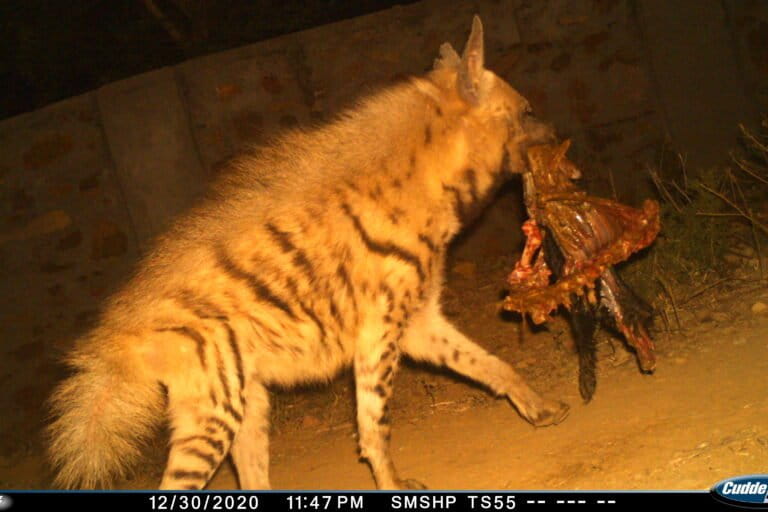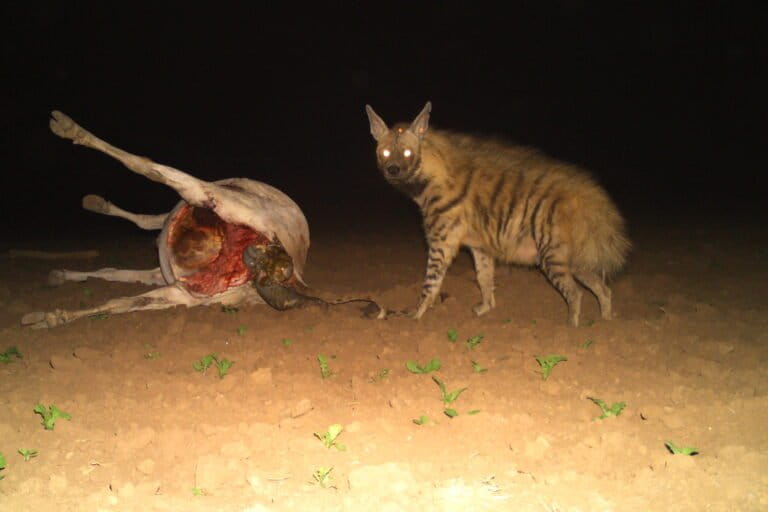- A new study estimates the monetary benefits of striped hyenas scavenging on livestock carcasses and wild prey in Rajasthan’s Sawai Mansingh Wildlife Sanctuary.
- The waste disposal services provided by striped hyenas may also play a role in hindering disease transmission.
- Educating local communities on the monetary benefits of striped hyenas scavenging services may play in role in removing their negative image and aid in the conservation of these carnivores.
While vultures are greatly appreciated for taking care of carcasses, there is another scavenger whose contribution is often overlooked: the humble hyena. A new study, published in August, found that striped hyenas in Sawai Mansingh Wildlife Sanctuary in the state of Rajasthan gobbled up 23 tons of livestock carcasses and 17 tons of wild prey every year, during the study period 2019 to 2020, saving thousands of dollars in carcass removal costs through electrical cremation or pyre burning. The study is one of the first estimations of monetary benefits from scavenging by striped hyenas in a human-dominated landscape.
“We found that striped hyenas are removing a vast amount of livestock and wild prey carcasses, which not only helps reduce the risk of disease transmission and maintains the overall cleanliness of the environment but also, saves artificial carcass disposal costs,” says Randeep Singh, Associate Professor at Amity Institute of Forestry and Wildlife, Amity University, Uttar Pradesh and an author of the study. “This study could improve their often-negative public image and support their conservation,” added Singh.
Four species of hyenas exist in the world, of which, one, the striped hyena, is found in India. Sporting a dog-like appearance, striped hyenas (Hyaena hyaena) are large, solitary carnivores that inhabit arid and semiarid landscapes from East Africa to South Asia. The shy, nocturnal animals rarely hunt or kill livestock. Instead, they feed opportunistically on remains of animals predated by larger carnivores such as tigers and leopards and discarded domestic livestock carcasses.

Due to the large number of livestock and poor sanitation, local people living in the area tend to dump carcasses in open areas and along roadsides, making waste management one of the most critical public issues in the region. Consequently, the region is vulnerable to the spread of zoonotic diseases, further threatening livestock and human health.
“Hyenas have a bad name and often conjure emotions of revulsion and disgust,” says Andrew Abraham, Marie Skłodowska-Curie Actions Fellow at Aarhus University, Denmark, who was not involved in the study. “Yet, the latest scientific evidence suggests that hyenas are, in fact, an essential part of the ecosystem and provide numerous services that benefit humans.” This study, says Abraham, “adds to the growing body of evidence that hyenas are an important component of healthy landscapes.”
Carcass disposal costs
For the study, Singh and his colleagues quantified the economic contributions of the scavenging services rendered by striped hyenas to local people in Sawai Mansingh Wildlife Sanctuary, which is part of the management unit of Ranthambore Tiger Reserve in the state of Rajasthan. There are 75 villages within a 5-km buffer of the Sanctuary with around 100,000 people living in and around the area. Most of the people who live around the study area earn their livelihood primarily from agriculture supplemented by animal husbandry. Each month around 40 to 50 livestock die due to various causes (diseases, natural death or predation, for example), observed the researchers.
Using a photo capture approach, the researchers determined the minimum number of striped hyenas in the study area. To determine the proportion of livestock consumed by striped hyenas, the team collected and analysed scat samples of the animals. The monetary value of carcass disposal by two methods — electric cremation and pyre burning — was calculated.

“In the study site, the main diet of the striped hyenas is livestock, mainly cows and buffaloes,” says Singh. But wild prey such as nilgai, sambar, wild boar, and chital also contribute to the diet of striped hyenas, he adds.
The findings showed that striped hyenas removed about 23 tons or 4.4 percent of livestock carcass waste from a total of 525 tons of waste generated per year from 2019 to 2020, in the study area. The cost of removing this waste by electric cremation was estimated to be $7095 while pyre burning would have amounted to $49,665. Without the services of striped hyenas, disposal of carcasses would not only be expensive but also harmful to the environment, the researchers asserted.
Forest officials could use these monetary benefits for the management of striped hyenas and their habitats. “We recommend that our method for evaluating the economic benefits of scavenging by striped hyenas could be used in other areas where the livestock carcass disposal system is still challenging, and the striped hyenas are completely or partially dependent on livestock carcasses,” Singh suggests. In addition, he adds that this method could also be used to calculate the monetary value of scavenging for other scavengers such as jackals and foxes.

“We suggest that the hyena’s acquisition of livestock waste should not be hindered as previous studies in this area reported the poisoning of carcasses by locals, which could affect the striped hyenas’ assemblages, especially in rural areas with challenges in waste management,” Singh pointed out.
“By consuming livestock waste, hyenas can save local communities money by reducing the need to dispose of carcasses,” says Abraham, who was not part of the research. “What’s more, these scavengers may indirectly help communities by decreasing the potential of disease and by returning important nutrients back to the ecosystem.”
Abraham stresses that the research has implications for re-evaluating human relationship with animals that are commonly perceived unfavourably by local communities. “While it is important that we understand the economic impact of wildlife, including hyenas, we must be cautious not to only value wild animals through financial metrics,” he warns. “Animals have intrinsic value far beyond how they can save us money.”
Owing to their powerful jaws and teeth, hyenas have a unique ability to crush and consume bones. Without bone scavengers, skeletons would take many years to decompose depending on the environmental conditions.
In a study published in 2021, Abraham and his colleagues reported that the concentration of calcium and phosphorus, key components of bones, in hyena feces is between 1,000 to 20,000 times higher than in local soils in two reserves in southern Africa. “Consequently, the soils in which hyenas defecate will become enriched with these nutrients, changing the fertility of the landscape with important implications for plant growth, community composition and animal diet quality,” notes Abraham.
Conservation of striped hyenas and human-hyena coexistence
Most countries focus on conserving large carnivores such as leopards and tigers in protected areas. However, striped hyenas are often ignored, Singh notes.
The landscape inside and in the buffer area of Sawai Mansingh Wildlife Sanctuary is surrounded by a mosaic of forest, scrublands, grasslands, riverine areas, and agricultural lands. Striped hyenas occupy all these habitats. In agricultural lands, however, the activity of striped hyenas overlaps with that of humans where they peacefully coexist as hyenas benefit from anthropogenic food by scavenging while humans benefit from the non-lethal nature of hyenas and their waste removal services.

“Grasslands, scrublands and ravines should be protected because people are converting the lands for various purposes,” says Singh. Fostering peaceful coexistence between humans and hyenas would involve educating the locals, creating awareness, and implementing site-specific management and action plans, Singh added. The team calls for greater awareness among local communities to recognize and appreciate the monetary benefits provided by scavengers such as striped hyenas.
“On the other hand, carcass dumping grounds near villages should be properly managed to ensure that people dump the carcasses on the ground but not near the roads because it could lead to hyena-vehicle collisions,” cautions Singh.
Banner image: Representative image of striped hyena. Photo by Rushikesh Deshmukh DOP/Wikimedia Commons.
